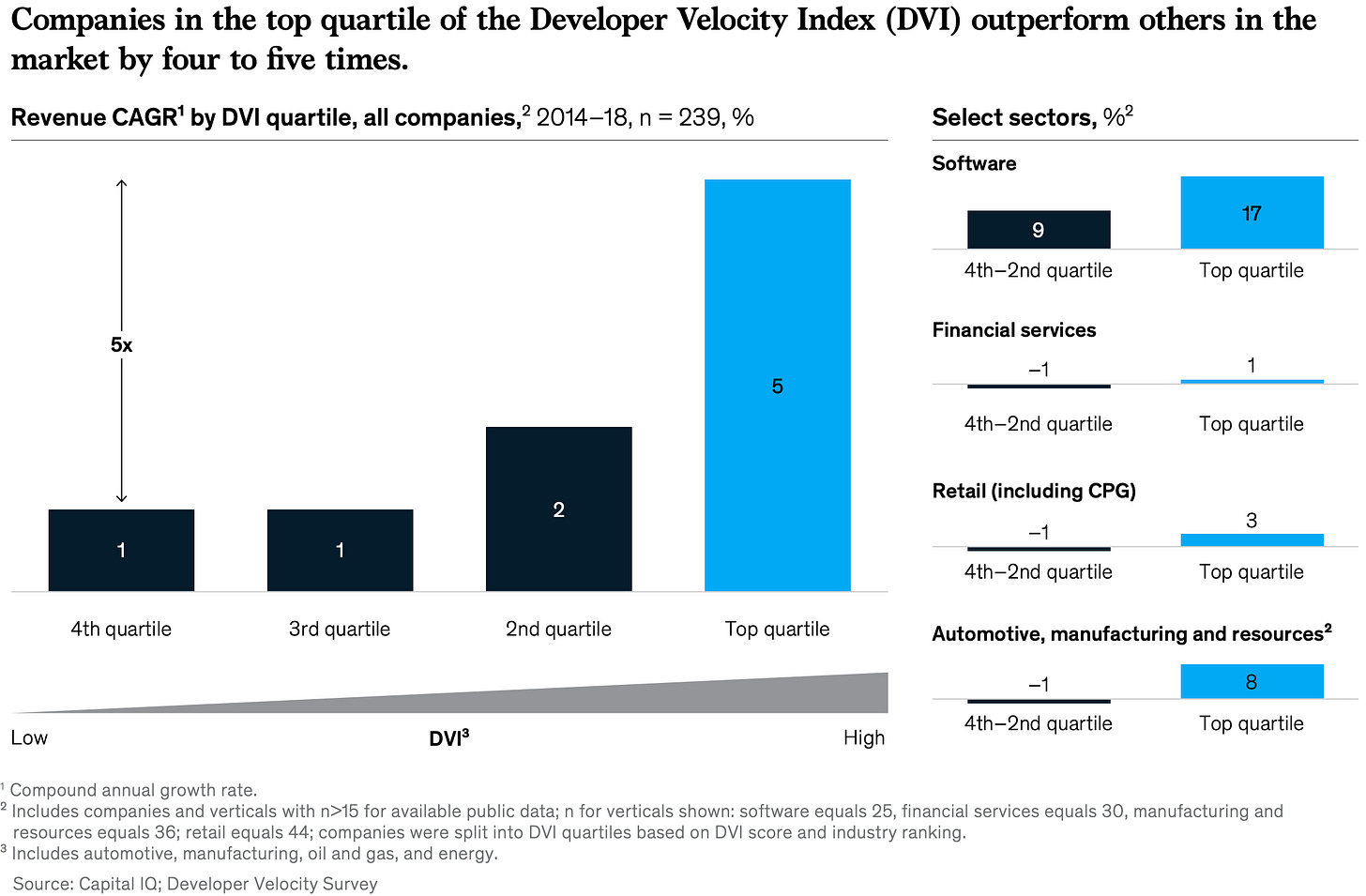Master the Secret Strategy That Transforms Your Business into a Market Leader
McKinsey-backed insights for maximizing returns from the software investments. Discover strategies to achieve 5x higher revenue by empowering Developer Velocity and optimising Talent Management!
Hello everyone, and welcome back to Tech Setters, your go-to spot for all things tech, innovation, and digital transformation. In today's episode, we're diving into the world of Developer Velocity and Talent Acquisition, concepts that could supercharge your business growth. We'll explore how to build an exceptional development team, unlocking innovation, agility, and a massive competitive edge.
Whether you're brainstorming the next big startup idea or fine-tuning processes in a Fortune 500 company, understanding and empowering Developer Velocity, coupled with strategic Talent Management, could be your secret sauce to achieving up to 5x higher revenue. Stick around as I promise you a strategy to elevate your team's potential and catapult your business into new heights.
Understanding Developer Velocity (DV)
Let's talk first about Developer Velocity (DV). It's a fancy term for a simple idea: how efficiently can your dev team turn ideas into working software? But here's the important part – it's not about coding faster or pushing your software teams to the boundary.
Let's kick things off with a clear definition:
Developer Velocity (DV) has two key aspects:
Individual Developer Velocity: This is the speed of a single developer. It's about how quickly an individual can turn ideas into working code.
Organizational Developer Velocity: This broader concept focuses on how efficiently an entire development team or organization can innovate and deliver software solutions.
In agile frameworks like Scrum, velocity is often measured in story points to help plan sprints. But Developer Velocity goes beyond that.
The Bigger Picture
While individual speed matters, when we talk about Developer Velocity in an organizational context, we're looking at the whole ecosystem. The term addresses the question of how efficient all processes are across the entire development cycle.
Here's something that often gets overlooked: you need solid software architecture as your base. Good architecture means not only your systems can grow without falling apart, but it allows developers to add new features more easily while keeping everything running smoothly. Plus, it saves your engineers from major headaches down the road.
Moreover, DV is a critical predictor of new feature releases and their timing. By optimizing DV, organizations ensure that their development teams are not only capable of delivering features rapidly but also consistently aligned with the strategic roadmap. This alignment is crucial in executing the organizational plan as scheduled, enabling the company to meet its business objectives and maintain a competitive edge in the market.
Key Ingredients for Developer Velocity
So what does it take to boost your DV? Here are the essentials:
Give your devs the best tools;
Automate anything that can be automated;
Create an environment of a positive culture;
Set up ways to provide quick feedback;
You may ask, why should we care? Companies that nail Developer Velocity see some serious benefits. In short: they make more money.
Developer Velocity as a main driver for company’s grows
All business leaders around the world constantly seeking ways to give our company an edge – the ability to out-innovate, outmaneuver, and frankly, outperform the competition. That's why my attention has been captured by the recent research on "Developer Velocity" from McKinsey & Company management consulting company. This study from McKinsey reveals a profound truth: the caliber of your software development directly translates into the success of your entire business.
So what exactly is Developer Velocity? Like we explored before, it goes beyond programmers just coding quickly. It's about creating an environment where developers are empowered to unleash their full potential, driving true value creation through software. McKinsey's Developer Velocity Index (DVI) breaks down the elements that contribute to this index, from cutting-edge technical tools to a culture and organizational enablement that embraces innovation.
The numbers speak for themselves. Companies with top scores on the DVI see:
revenue growth up to five times higher than the bottom performers
60 percent higher total shareholder returns
20 percent higher operating margins
55 percent higher on innovation than bottom-quartile companies
Higher shareholder returns, better innovation, improved customer satisfaction. Just wow, isn't it? The correlation across almost every business metric is undeniable.
Key for Management: Where We Can Make an Impact
Tools that Empower
The study reveals that providing developers with access to the best tools across areas like coding, testing, and deployment directly impacts their output and job satisfaction;
Investing in automation and streamlining processes frees up developer time, allowing them to focus on solving core problems instead of wrestling with clunky technology;
Proactive tool evaluation ensures the team has the most effective tech to stay ahead of the curve, this signals to top talent that their skills are valued;
A Culture of Calculated Risks
True innovation often requires experimentation. McKinsey's research highlights that companies with a culture of “psychological safety” – where trying new approaches and even occasional smart failures are accepted – show higher DVI scores;
Balancing the need for speed with thoroughness is key. Management needs to set a tone where calculated risk-taking is encouraged alongside rigorous testing;
Celebrating success and analyzing failures as learning opportunities reinforces the desire to innovate;
Product Management as an Art
Companies that excel in product management outpace competitors in the DVI; The product-management team not only needs relevant business and market knowledge but also a strong technical background;
Embedding customer insights into the development process is critical. Ask yourself a question: Are product managers gathering market intelligence and effectively translating it into development priorities;
Fostering collaboration between product managers and engineers is essential. This ensures the team stays focused on delivering market-driven solutions;
Harnessing the Power of Open-Source and AI
McKinsey's research also shows that top-quartile companies are increasingly exploring the use of artificial intelligence (AI) and machine learning to enhance developer tools. These AI-powered tools offer the potential to streamline coding, automate testing, and provide intelligent recommendations, further boosting developer productivity;
For organisations already demonstrating strong Developer Velocity, open-source adoption serves as a major accelerator. The data reveals that top-quartile companies see three times the impact on innovation from open-source solutions compared to those in other quartiles;
Building a true open-source culture extends beyond simply utilizing open-source software in code. It involves encouraging contribution to external open-source communities and adopting a similar open approach to internal code sharing practices;
Talent is Everything
Another McKinsey's takeway is that attracting and retaining top engineers is vital. These star developers have an outsized impact on code quality, innovation, and even team morale;
Focusing on talent development beyond initial onboarding pays dividends. Another question to ask: Are mentorship programs, training opportunities, and clear career paths provided; Companies having clear career guidelines are often more attractive for employees.
Managers need to foster an environment where collaboration, knowledge sharing, and burnout prevention are prioritized. Successful companies pay attention to team health.
The McKinsey study makes it clear that the companies leading in Developer Velocity Area are outpacing the competition across almost every metric. Ignoring these findings simply puts you at a strategic disadvantage. At the same time this research offers a compelling roadmap, urging us to invest in top-tier tools, foster a culture of innovation, prioritize our talent, and embrace the strategic use of open-source and AI solutions.
The Hidden Power of the Strategic Talent Acquisition
Building on the McKinsey study, which emphasises talent as a key driver of growth, my experience not only confirms this but also has taught me something crucial. One of the most overlooked foundations driving long-term organisational success is the hiring process. It sounds simple, right? Yet, many companies fall into a dangerous trap: they see developers as interchangeable units rather than the creative, problem-solving powerhouses they are.
Much research confirms, and many developers working in the field can attest, that skill variance among developers is real – and it has a massive impact on a company's bottom line. Top-tier developers don't just write code faster. Their solutions are better designed, less prone to bugs, and ultimately save time and resources in the long run.
But here's something often missed: it's not just about the individual, it's about the team dynamic. Researches based on model the COCOMO demonstrates that the overall skill level of your development group is the single most critical factor impacting productivity. This means that even a few stellar developers can massively elevate the entire team's output.
The Challenge of Delayed Consequences
The tricky part is that the consequences of hiring decisions often aren't immediate. A team packed with low-skilled developers might seem to hum along initially. But over time, that poorly-architected codebase turns into a tangled mess. Productivity grinds to a halt, innovation suffers, and your best engineers start heading for greener pastures.
This speaks to a broader issue within systems thinking: the impact of delayed effects and feedback loops. When results don't immediately follow actions, it's incredibly difficult to learn from mistakes and course-correct. This delay is why so many companies fail to make the connection between hiring practices and their long-term growth trajectory.
The Self-Reinforcing Spiral (and How to Break It)
Picture this: a company prioritizing short-term budget cuts over long-term code quality will naturally attract less-skilled developers. Those developers, without mentorship and examples of clean code, won't have the same growth opportunities. That leads to even more compromised code, driving away skilled developers who would otherwise be invaluable. It's a vicious cycle.
So, how do we turn this ship around? Here's where your management audience can benefit:
Invest in Excellence: Yes, top-tier developers likely cost more upfront. But consider the cost of rework, bottlenecks, and lost innovation that come with an under-skilled team. A few stars truly outweigh a horde of mediocre programmers.
Prioritize mentorship: Don't just hire developers, create an environment where they can truly grow. Senior engineers guiding juniors pays dividends in code quality and team retention.
The Long Game: Remind management that hiring isn't about filling seats today, it's about building a sustainable engine for the company's future. Decisions made now will echo throughout the organization for years to come.
Ultimately, the power to shape a company's trajectory lies in those seemingly mundane hiring decisions. As leaders, we have a choice: continue with the status quo of cost-cutting and short-term thinking, or invest in building a truly exceptional development team. The first path might offer a temporary illusion of savings and progress still going on. The second path requires foresight and a belief in the power of human talent. It's the path that lays the foundation for sustainable growth, agility, and the ability to consistently deliver cutting-edge solutions.
And that wraps up our deep dive into the transformative powers of Developer Velocity and Talent Acquisition. In a world driven by technology, complacency isn't an option. Companies that prioritize the right directions will be the ones that shape the future, while those stuck in old patterns risk fading into irrelevance.
The journey to achieving up to 5x higher revenue through discussed strategies isn't just about speed; it's about creating an environment where talent thrives, innovation flourishes, and your business models are aligned with the cutting-edge practices endorsed by leading research consultancies like McKinsey.
Thank you for joining me on Tech Setters for this enlightening exploration. I am excited to see how you'll implement these strategies to not only meet but exceed your business goals. Stay tuned for more insights on tech, innovation, and digital transformation that keep you ahead of the curve. Until next time, keep setting the tech world on fire!
🔍 Explore more




